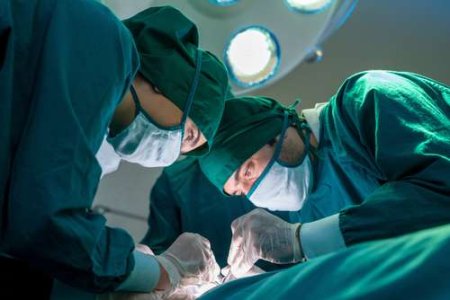Are you worried? Expert unveils secrets behind bumps and lumps
- Replies 0
Disclaimer: The content presented in this article should not be construed as medical advice. It is advisable for readers to seek guidance from their healthcare providers before engaging in any activities or treatments discussed.
Are you concerned about unexpected lumps or bumps?
An expert recently shed light on various swellings that may appear on the body, offering insights and advice to help you understand and address these issues.
Whether it's a new discovery or a persistent concern, understanding the potential causes and seeking appropriate medical guidance is essential for peace of mind and proactive health management.
Dr Naveen Puri, a Medical Director at Bupa Insurance, is a medical professional with over a couple of decades of experience.
He shared insights that could help us discern when a lump might be a cause for concern.
Lumps on your fingers
If you've noticed a lump on your finger, it could be a ganglion cyst.
‘Ganglion cysts are fluid-filled swellings which commonly develop near joints or tendons—particularly on wrists, hands, and fingers,’ Dr Puri said.
‘They can range from the size of a pea to the size of a golf ball.’
According to him, while typically benign, these growths might cause discomfort.
He also advised to consult a healthcare provider if you experience pain as they can suggest interventions like draining the fluid, or surgical removal of the cyst for relief.
Another possibility is Heberden's nodes.
‘Heberden's nodes are small, bony growths which form on the joints closest to fingertips. They're a symptom of osteoarthritis, where cartilage in the bone joint rubs away and leads to inflammation and pain,’ Dr Puri explained.
He suggested consulting with a general practitioner for guidance on potential treatment options and self-care strategies.
Warty growths on the fingers are also common, and can be treated with over-the-counter remedies.
These growths may appear grainy with tiny black dots, which are actually small, clotted blood vessels.
Breast lumps
While most breast lumps are not cancerous, discovering one can be particularly alarming for women due to their association with breast cancer.
Dr Puri emphasised the importance of regular self-examinations saying, ‘You should regularly check your breasts for cancerous lumps.’
He asked everyone to be vigilant for changes in texture, thickening, or the appearance of new lumps in the breast or armpit; changes in the size, shape, or sensation of the breasts or nipples; changes in breast texture such as dimpling or puckering; shifts in colour; and/or discharge or fluid from the nipples.
He also encouraged that if you observe any lumps or alterations in your breast, have them examined by your GP.
Fibroadenomas are one type of benign lump, often feeling firm, smooth, and rubbery.
‘These lumps are often firm, smooth, and rubbery in texture. They are not a cause for concern, but you'll need a review from a health professional to determine this,’ Dr Puri explained.
Hormonal fluctuations during the menstrual cycle can also cause the breasts to feel lumpy or tender, but these changes typically subside after the cycle ends.
‘If these breast changes follow a similar pattern of appearing and disappearing during the course of your cycle, then it's likely to be normal for you, and not anything you need to worry about,’ he added.
Persistent lumps, however, should be evaluated by a health professional.
Breastfeeding may also cause the feeling of a lump if milk ducts become blocked during breastfeeding.
Additionally, internal bruising or bleeding can result in lumps or changes in the texture of the breast.
‘There might be a breakdown of the fat within your breast, known as fat necrosis,’ Dr Puri said.
‘This can lead to an unevenness in the feel of the affected breast, which may look like a lump.’
‘However, if you have a breast lump that you're worried about, you should always speak to a health professional as soon as possible for their advice,’ he added.
Skin lumps
While self-examinations on the breast are encouraged, when it comes to lumps on the skin, self-diagnosis is not recommended.
‘Always speak to a health professional, especially if the lump has been there for two weeks,’ Dr Puri advised.
Skin tags, for instance, are usually harmless, but should be assessed by a doctor if they become painful or change in appearance.
‘Don't try and remove these on your own,’ he warned.
‘Speak to a health professional if it becomes painful, starts bleeding, gets bigger or starts to multiply.’
If pain is felt, the lump could be abscesses, which are caused by an infection, and can be found deep in the skin as well.
‘They're often circular, contain pus, and may feel warm and sore,’ Dr Puri said.
‘You're more likely to get a skin abscess if you smoke, are obese, have diabetes, have a skin condition like eczema, or are aged between 15 and 40.’
Lumps on the neck or armpit
Swollen lymph nodes in areas like the neck, armpits, or groin can occur when you have an infection or virus, according to Dr Puri.
‘These areas are connected to your lymph nodes, which help to fight off infection,’ he said.
‘Lymph nodes will swell up, and can be more easily felt if you have an infection.’
‘Rarely, swollen lymph nodes can be a sign of cancer,’ he added.
While this is often normal, persistent swelling without a recent infection could be a sign of something more serious, such as cancer, and warrants a visit to the GP.
Testicular lumps
According to Dr Puri, men should be aware of any changes or lumps in the testicles.
‘They may not be caused by cancer, but it's always best to rule it out,’ he said.
‘Possible causes of testicular lumps include cysts or infection, as well as possible testicular cancer, which can only be ruled out with an appropriate scan once a doctor sees you.’
Lumps inside your mouth
Dr Puri assured that lumps in this area typically resolve on their own, particularly if they arise from infection or inflammation.
‘Rinsing with warm saltwater a few times each day can help ease pain, along with taking over-the-counter painkillers and avoiding tobacco products—if you're a smoker,’ he explained.
‘Eating cold foods and avoiding spice and citrus can help, too.’
However, he cautioned that they should be checked by a health professional if they persist or grow.
A lump inside your bottom
It's typical for lumps to develop within the rectal area, and discovering a painless lump near the opening of the anus typically doesn't raise significant concerns, according to Dr Puri.
‘The most common lump in or around the bottom is a haemorrhoid, more commonly referred to as “piles”,’ he said.
‘In some cases, haemorrhoids can become painful, so medical review should be sought if this is the case. Anal warts are another type of painless lump around the anus.’
He also explained that if you detect a firm lump near the opening of your anus accompanied by discomfort, discharge, itching, swelling, alterations in bowel movements, or bleeding, it may indicate the presence of anal or rectal cancer.
‘Always speak to a GP,’ he advised.
One of the worries when noticing bumps and lumps in the body is cancer.
However, Dr Puri mentioned that most of these do not automatically mean having the disease.
If you’re looking for more accurate symptoms, you can learn more here.
 Have you noticed any bumps or lumps in your body? What was your experience with them? Share them with us in the comments below.
Have you noticed any bumps or lumps in your body? What was your experience with them? Share them with us in the comments below.
Are you concerned about unexpected lumps or bumps?
An expert recently shed light on various swellings that may appear on the body, offering insights and advice to help you understand and address these issues.
Whether it's a new discovery or a persistent concern, understanding the potential causes and seeking appropriate medical guidance is essential for peace of mind and proactive health management.
Dr Naveen Puri, a Medical Director at Bupa Insurance, is a medical professional with over a couple of decades of experience.
He shared insights that could help us discern when a lump might be a cause for concern.
Lumps on your fingers
If you've noticed a lump on your finger, it could be a ganglion cyst.
‘Ganglion cysts are fluid-filled swellings which commonly develop near joints or tendons—particularly on wrists, hands, and fingers,’ Dr Puri said.
‘They can range from the size of a pea to the size of a golf ball.’
According to him, while typically benign, these growths might cause discomfort.
He also advised to consult a healthcare provider if you experience pain as they can suggest interventions like draining the fluid, or surgical removal of the cyst for relief.
Another possibility is Heberden's nodes.
‘Heberden's nodes are small, bony growths which form on the joints closest to fingertips. They're a symptom of osteoarthritis, where cartilage in the bone joint rubs away and leads to inflammation and pain,’ Dr Puri explained.
He suggested consulting with a general practitioner for guidance on potential treatment options and self-care strategies.
Warty growths on the fingers are also common, and can be treated with over-the-counter remedies.
These growths may appear grainy with tiny black dots, which are actually small, clotted blood vessels.
Breast lumps
While most breast lumps are not cancerous, discovering one can be particularly alarming for women due to their association with breast cancer.
Dr Puri emphasised the importance of regular self-examinations saying, ‘You should regularly check your breasts for cancerous lumps.’
He asked everyone to be vigilant for changes in texture, thickening, or the appearance of new lumps in the breast or armpit; changes in the size, shape, or sensation of the breasts or nipples; changes in breast texture such as dimpling or puckering; shifts in colour; and/or discharge or fluid from the nipples.
He also encouraged that if you observe any lumps or alterations in your breast, have them examined by your GP.
Fibroadenomas are one type of benign lump, often feeling firm, smooth, and rubbery.
‘These lumps are often firm, smooth, and rubbery in texture. They are not a cause for concern, but you'll need a review from a health professional to determine this,’ Dr Puri explained.
Hormonal fluctuations during the menstrual cycle can also cause the breasts to feel lumpy or tender, but these changes typically subside after the cycle ends.
‘If these breast changes follow a similar pattern of appearing and disappearing during the course of your cycle, then it's likely to be normal for you, and not anything you need to worry about,’ he added.
Persistent lumps, however, should be evaluated by a health professional.
Breastfeeding may also cause the feeling of a lump if milk ducts become blocked during breastfeeding.
Additionally, internal bruising or bleeding can result in lumps or changes in the texture of the breast.
‘There might be a breakdown of the fat within your breast, known as fat necrosis,’ Dr Puri said.
‘This can lead to an unevenness in the feel of the affected breast, which may look like a lump.’
‘However, if you have a breast lump that you're worried about, you should always speak to a health professional as soon as possible for their advice,’ he added.
Skin lumps
While self-examinations on the breast are encouraged, when it comes to lumps on the skin, self-diagnosis is not recommended.
‘Always speak to a health professional, especially if the lump has been there for two weeks,’ Dr Puri advised.
Skin tags, for instance, are usually harmless, but should be assessed by a doctor if they become painful or change in appearance.
‘Don't try and remove these on your own,’ he warned.
‘Speak to a health professional if it becomes painful, starts bleeding, gets bigger or starts to multiply.’
If pain is felt, the lump could be abscesses, which are caused by an infection, and can be found deep in the skin as well.
‘They're often circular, contain pus, and may feel warm and sore,’ Dr Puri said.
‘You're more likely to get a skin abscess if you smoke, are obese, have diabetes, have a skin condition like eczema, or are aged between 15 and 40.’
Lumps on the neck or armpit
Swollen lymph nodes in areas like the neck, armpits, or groin can occur when you have an infection or virus, according to Dr Puri.
‘These areas are connected to your lymph nodes, which help to fight off infection,’ he said.
‘Lymph nodes will swell up, and can be more easily felt if you have an infection.’
‘Rarely, swollen lymph nodes can be a sign of cancer,’ he added.
While this is often normal, persistent swelling without a recent infection could be a sign of something more serious, such as cancer, and warrants a visit to the GP.
Testicular lumps
According to Dr Puri, men should be aware of any changes or lumps in the testicles.
‘They may not be caused by cancer, but it's always best to rule it out,’ he said.
‘Possible causes of testicular lumps include cysts or infection, as well as possible testicular cancer, which can only be ruled out with an appropriate scan once a doctor sees you.’
Lumps inside your mouth
Dr Puri assured that lumps in this area typically resolve on their own, particularly if they arise from infection or inflammation.
‘Rinsing with warm saltwater a few times each day can help ease pain, along with taking over-the-counter painkillers and avoiding tobacco products—if you're a smoker,’ he explained.
‘Eating cold foods and avoiding spice and citrus can help, too.’
However, he cautioned that they should be checked by a health professional if they persist or grow.
A lump inside your bottom
It's typical for lumps to develop within the rectal area, and discovering a painless lump near the opening of the anus typically doesn't raise significant concerns, according to Dr Puri.
‘The most common lump in or around the bottom is a haemorrhoid, more commonly referred to as “piles”,’ he said.
‘In some cases, haemorrhoids can become painful, so medical review should be sought if this is the case. Anal warts are another type of painless lump around the anus.’
He also explained that if you detect a firm lump near the opening of your anus accompanied by discomfort, discharge, itching, swelling, alterations in bowel movements, or bleeding, it may indicate the presence of anal or rectal cancer.
‘Always speak to a GP,’ he advised.
One of the worries when noticing bumps and lumps in the body is cancer.
However, Dr Puri mentioned that most of these do not automatically mean having the disease.
If you’re looking for more accurate symptoms, you can learn more here.
Key Takeaways
- Lumps on the body can range from harmless growths to signs of something more serious, such as cancer.
- Dr Naveen Puri, a doctor with over 20 years of experience, highlighted the importance of getting lumps checked by a GP, especially if they persist or cause concern.
- Lumps in specific areas, such as the breast, fingers, skin, neck, armpits, testicles, mouth, and bottom, have various potential causes that need professional evaluation.
- Regular self-examination is recommended, like checking breasts monthly, to notice any unusual changes that need medical attention.







